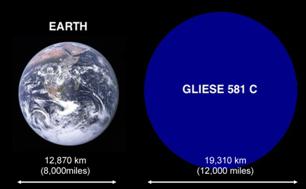
Geoscientist Online 9 May 2007
Astronomers have discovered the most Earth-like planet outside our Solar System to date, one which could even have liquid water running across its surface. Emily Baldwin reports.
In fact,
three planets have been found orbiting the same parent star - Gliese 581 - but only the one that orbits in the "Goldilocks zone" is creating great excitement among the scientific community. This zone is known the not-too-hot and not-too-cold "habitable" region around a star where water could exist as a liquid. Stephane Udry, the lead author of the paper reporting these findings has estimated that the mean temperature of the planet lies between 0 and 40 degrees Celsius, supporting the possibility that liquid water could indeed be stable. The new planet – assigned the name Gliese 581 C - may well provide a focus for future missions searching for extra-terrestrial life.
Although Gliese 581 C provides a seemingly temperate climate there are some striking differences between the Earth and its long lost sibling. Gliese 581 C orbits its parent star once every 13 days, compared with the Earth’s leisurely 365. It also orbits the star very closely, at a distance 14 times closer than the Earth to our Sun. The fact that the planet resides in the Habitable Zone comes from the observation that Gliese 581 is much smaller and less luminous than our own Sun.
Most of the 200-plus exoplanets already found are comparable in size and composition to gaseous Jupiter-type planets. This new planet is much smaller, and has a radius just 1.5 times that of the Earth, fitting models that suggest that the planet could be rocky.
This exciting new discovery was made by a team of astronomers using the European Southern Observatory facility based in the Atacama Desert. They used a technique to measure the tiny changes in the velocity of the parent star as it experiences the gravitational tug of a nearby planet.
In addition to the new ‘super-Earth’, there is a 15 Earth mass planet orbiting even closer to the parent star, and an 8 Earth mass planet lying further out. The results have been submitted to the Royal Astronomical Society's magazine Astronomy and Geophysics.